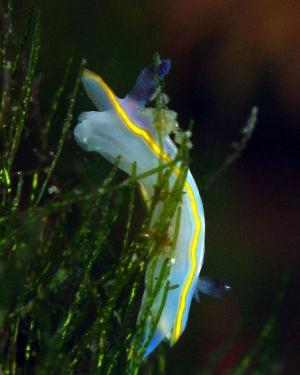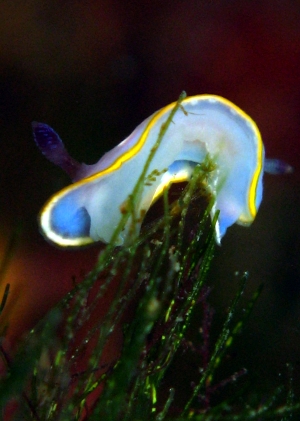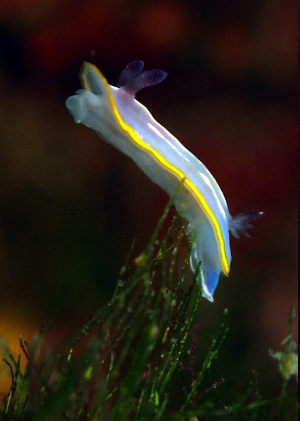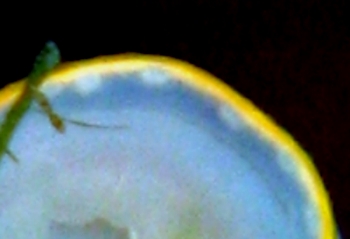
Chromodoris krohni
(Verany, 1846)
Order: NUDIBRANCHIA
Suborder: DORIDINA
Superfamily: EUDORIDOIDEA
Family: Chromodorididae
DISTRIBUTION
Fairly common from northern Spain to North Africa and the Mediterranean Sea.
PHOTO
Bay of Algeciras (Strait of Gibraltar, Southern Spain). UPPER RIGHT: Size: 22 mm., Depth: 23m., Date: October, 1999. LOWER LEFT: Size: 13 mm., Depth: 19 m., Date: January, 1999. LOWER RIGHT: Size: 22 mm., Depth: 23m., Date: October, 1999. PHOTOS: Alma Sánchez
Chromodoris krohni (Vérany, 1846) is fairly common from northern Spain to North Africa and the Mediterranean Sea. It is clearly distinguishable from other chromodorid species from the eastern Atlantic by the presence of three yellow lines on a pale blue background. The lines run from the gill area to the rhinophores, the two most external joining right behind the gill. In the adult specimens there are also small yellow dots next to the lines (Upper & Lower Right photos). In the juvenile specimens the lines are pale yellow or even white (Lower Left). Other eastern Atlantic species with yellow of white lines have a dark blue dorsal color and they belong to the genus Hypselodoris (H. tricolor, H. villafranca, H. bilineata, H. cantabrica, H. malacitana, H. picta, H. fontandraui and H. orsini. They are easily distinguishable from C. krohni by the narrower mantle margin and absence of mantle glands in large areas of the mantle edge. A probably related species to C. krohni is Chromodoris purpurea (Risso in Guérin, 1831), which is very similar but lacks yellow lines. Because of the pale blue background color this species was not included in the monograph by Ortea et al. (1996) dealing with the dark blue Atlantic chromodorids.
Angel Valdes
Reference:
• Ortea, J., Valdés, Á. & García-Gómez, J.C. (1996) Revisión de las especies atlánticas de la familia Chromodorididae (Mollusca: Nudibranchia) de grupo cromático azul. [Review of the Atlantic species of the family Chromodorididae (Mollusca: Nudibranchia) of the blue chromatic group.] Avicennia. Revista de Ecologia y Oceanologia y Biodiversidad Tropical. Supplement 1. 165pp.
• Schmekel, L. & Portmann, A. (1982) Opisthobranchia des Mittelmeeres. Springer-Verlag: Berlin. 410pp.


Valdes, A., 2001 (January 21) Chromodoris krohni (Verany, 1846). [In] Sea Slug Forum. Australian Museum, Sydney. Available from http://www.seaslugforum.net/find/chrokroh
Related messages
Chromodoris krohni from French Mediterranean
June 25, 2007
From: Dominique Horst

Hello Bill,
Meeting a Chromodoris krohni is not very frequent in our area.
Locality: Cannes, 25 m, France, Mediterranean sea, 8 May 2007. Length: 9 mm. Photographer: Dominique HORST.
I've observed this one a long time and I was surprised to see the slug voluntarily releasing itself to be taken by the current when it reached the end of the algae on which it was crawling.
Kind regards,
Dominique
dominique.horst@wanadoo.fr



Dear Dom,
I must say I have never seen a nudibranch actually release itself like that - quite a risky behaviour. Looking at one of your photos I noticed some white bumps along the underside of the mantle edge. These must be the mantle glands [= mantle dermal formations] in which chromodorids accumulate the secondary metabolites they acquire from their sponge food. It's not usual for species of Chromodoris to have small discrete glands like this, usually their glands are very branched and digitiform.
Best wishes,
Bill Rudman
Chromodoris krohni from Portugal
May 4, 2006
From: David Abecasis


Hi Bill,
I'm not sure, but I believe this is a species of Chromodoris.
Locality: Praia do Burgau, Lagos, 8 metres, Portugal, Atlantic Ocean, 30 April 2006, wreck in sandy bottom. Photographer: David Abecasis.
Thanks,
David Abecasis
davidbecas@netcabo.pt
Abecasis, D., 2006 (May 4) Chromodoris krohni from Portugal. [Message in] Sea Slug Forum. Australian Museum, Sydney. Available from http://www.seaslugforum.net/find/16515
Dear David,
I am pretty sure this isChromodoris krohni. It looks quite like C. purpurea, but as your photos of that species show [message #16514], that species lacks longitudinal white lines on the mantle, and has white tipped gills and rhinophores.
Best wishes,
Bill Rudman
Chromodoris krohni from French Mediterranean
July 29, 2003
From: Marina Poddubetskaia

Dear Bill,
To accompany my message on Chromodoris britoi from Cerbere here is a photo of the very similar Chromodoris krohni.
Date: July 13, 2003
Location : Cerbere, France, Mediterranean coast
Site: Les Chambres
Depth: 8m
Size: 12-14mm
Photo: Marina Poddubetskaia - Nembro website
Cordially,
Marina.
nembro@nembro.info


Dear Marina,
I have included these close-ups of the gills and rhinophores to show the uniform nature of the coloration in C. krohni. There are no signs of the white and purple pigmentation being concentrated in lines on the gills and rhinophores as in C. britoi.
Best wishes,
Bill Rudman
Re: Chromodoris krohni from Turkey
July 22, 2003
From: Baki Yokes

Dear Bill,
To accompany Haluk Akbatur's message, I happened to encounter more than ten Chromodoris krohni in Turkish waters. As fate would have it I unfortunately always been equipped with an unsuitable lens set, so that I haven't yet been able to take a good picture of this species yet (sorry for the blured photo). As far I observe, the Turkish specimens of C. krohni always have the yellow midline, but the secondary lines may or may not be present. None of the specimens had yellow spots.
Bodrum, Turkey
Divesite: Big Reef
Depth: 9m
Date: January, 2001
Best wishes
Baki
bakiyokes@turk.net
Yokes, B., 2003 (Jul 22) Re: Chromodoris krohni from Turkey. [Message in] Sea Slug Forum. Australian Museum, Sydney. Available from http://www.seaslugforum.net/find/10508Thanks Baki,
I haven't had confirmation yet that my identification is correct, but I am fairly confident that it is
Bill Rudman
Chromodoris krohni or C. tricolor? from Turkey
July 17, 2003
From: Haluk Akbatur


Dear Bill,
What is your opinion about this dorid. Erwin Koehler thinks it might be a variant of Chromodoris tricolor.
Photos were taken by Nazmi Kural,
Photo details:
size: 10 mm
depth: 12 m
date: July 4, 2003
country: Turkey
village: Kekova
divesite: Akarbogaz
Thanks for your help
Haluk Akbatur
lasergoz@ttnet.net.tr
Akbatur, H., 2003 (Jul 17) Chromodoris krohni or C. tricolor? from Turkey. [Message in] Sea Slug Forum. Australian Museum, Sydney. Available from http://www.seaslugforum.net/find/10451Dear Haluk,
I am pretty sure it is a variant of Chromodoris krohni. It is the opposite extreme to the spotted animals recently posted from Senegal. Hypselodoris tricolor can have a single yellow median line bordered with white, but it doesn't have secondary yellow longitudinal lines like the ones in your animal. Also the gills and rhinophores of H. tricolor are dark blue, the gills edged in white. In your animal the gills and rhinophores are translucent reddish purple, more heavily pigmented towards the tip, which appears to be a characteristic of Chromodoris krohni.
I am somwhat fearful of trying to identify these 'blue chromodorids' of the Mediterranean so I'll conclude my remarks by saying there's a chance I am quite wrong. If I am I am sure some kind person will let us know
Best wishes,
Bill Rudman
Chromodoris krohni from Senegal
July 7, 2003
From: Marina Poddubetskaia


Dear Bill,
Short time ago I sent you photos taken by Patrice in Senegal which you identified as Chromodoris krohni. During my recent stay in Dakar I found 2 similar animals. Here are the photos of one of them. Lucas Cervera has confirmed it is Chromodoris krohni. So, you were right.
Date: May 26, 2003
Location: Dakar, Senegal, Eastern Atlantic
Site: Tacoma Wreck
Depth: 13m
Size: 20mm
Photos: Marina Poddubetskaia - Nembro website
Cheers,
Marina.
nembro@nembro.info
Poddubetskaia, M., 2003 (Jul 7) Chromodoris krohni from Senegal. [Message in] Sea Slug Forum. Australian Museum, Sydney. Available from http://www.seaslugforum.net/find/10372Thanks Marina,
It's good to get confirmation from Lucas. Its interesting to see how colour patterns can gradually change in species with a large geographic distribution. In this case the 3 longitudinal lines are replaced, or partially replaced by spots. Your visit to Senegal has proved very valuable
Best wishes,
Bill Rudman
Chromodoris krohni? from Senegal
May 23, 2003
From: M. Poddubetskaia & P. Petit de Voize


Dear Bill,
I know you ‘like’ blue dorids from Mediterranean: some of them seem quite difficult to identify. So, I thought you could be glad to have this one from Dakar (Senegal, Atlantic) :-)
We would like to have your opinion on this identification, please. Patrice took these photos on the M'bao wrecks in April 1999, at a depth of 10m.
Best wishes,
Marina Poddubetskaia
nembro@nembro.info
Patrice Petit de Voize
PdeVoize@aol.com
Poddubetskaia, M. & Petit de Voize, P., 2003 (May 23) Chromodoris krohni? from Senegal. [Message in] Sea Slug Forum. Australian Museum, Sydney. Available from http://www.seaslugforum.net/find/9675Dear Marina and Patrice,
I am pretty sure this is a colour form of Chromodoris krohni. 'Typical' specimens usually have 3 yellowish lines on the mantle and scattered spots of the same colour. In this specimen the three lines seem to be replaced by rows of spots - one median, and one on each side. The colour of the gills and rhinophores is the same and the mantle glands appear as a bluish white band just inside the yellow border. If it is C. krohni it is a bit further south than its known distribution in the Mediterranean and nearby Atlantic. Any comments would be welcome.
Best wishes
Bill Rudman
Chromodoris krohni from French Mediterranean
July 24, 2002
From: Marina Poddubetskaia

Dear Bill,
Here is a photo of Chromodoris krohni. This species looks like Chromodoris britoi. According to Jean-Pierre Bielecki, to distinguish these two species, you have to look at the median line: C. britoi has always a darker yellow or orange patch in the centre of this line and C. krohni hasn't it.
Date: July 02, 2002
Location: Cerbere, France [Mediterranean coast]
Site: L'Ocell
Size: about 2cm
Best wishes,
Marina.
Photos: Marina Poddubetskaia - Nembro website
nembro@nembro.info
Poddubetskaia, M., 2002 (Jul 24) Chromodoris krohni from French Mediterranean. [Message in] Sea Slug Forum. Australian Museum, Sydney. Available from http://www.seaslugforum.net/find/7590Thanks Marina,
Bill Rudman
Chromodoris krohni from Spain
January 24, 2001
From: Alma Sánchez

Dear Dr. Rudman,
Here are three photos of Chromodoris krohni (Vérany, 1846) for your Forum. The lower left photo shows the typical colour pattern. However, in the other photos there are well-defined, irregular and yellow dorsal spots, surrounded by thin white lines.
Data:
Bay of Algeciras (Strait of Gibraltar, Southern Spain). UPPER RIGHT: Size: 22 mm., Depth: 23m., Date: October, 1999. LOWER LEFT: Size: 13 mm., Depth: 19 m., Date: January, 1999. LOWER RIGHT: Size: 22 mm., Depth: 23m., Date: October, 1999.
Best Wishes
Alma Sánchez


Dear Alma,
Thanks very much for sharing your beautiful photos with us. Angel Valdes has kindly provided some background information on the species.
Best wishes,
Bill Rudman
Re: Chromodoris krohni
January 24, 2001
From: Angel Valdes
Dear Bill,
I took a look at Alma's photos and I do not have any doubt that they are of specimens of Chromodoris krohni (Vérany, 1846). It is fairly common from northern Spain to North Africa and the Mediterranean Sea. It is clearly distinguishable from other chromodorid species from the eastern Atlantic by the presence of three yellow lines on a pale blue background. The lines run from the gill area to the rhinophores, the two most external joining right behind the gill. In the adult specimens (upper and lower right photos)there are also small yellow dots next to the lines. In the juvenile specimens the lines are pale yellow or even white (lower left photo). Other eastern Atlantic species with yellow of white lines have a dark blue dorsal color and they belong to the genus Hypselodoris (H. tricolor, H. villafranca, H. bilineata, H. cantabrica, H. malacitana, H. picta, H. fontandraui and H. orsini. They are easily distinguishable from C. krohni by the narrower mantle margin and absence of mantle glands in large areas of the mantle edge. A probably related species to C. krohni is Chromodoris purpurea (Risso in Guérin, 1831), which is very similar but lacks yellow lines (I enclose a photo taken in northern Spain). Because of the pale blue background color this species was not included in the monograph by Ortea et al. (1996) dealing with the dark blue Atlantic chromodorids.
• Jesús Ortea, Ángel Valdés and José Carlos García-Gómez, (1996) Revisión de las especies atlánticas de la familia Chromodorididae (Mollusca: Nudibranchia) de grupo cromático azul. [Review of the Atlantic species of the family Chromodorididae (Mollusca: Nudibranchia) of the blue chromatic group.] Avicennia. Revista de Ecologia y Oceanologia y Biodiversidad Tropical. Supplement 1. 165pp.
All the best,
Angel
avaldes@CalAcademy.org
Valdes, A., 2001 (Jan 24) Re: Chromodoris krohni. [Message in] Sea Slug Forum. Australian Museum, Sydney. Available from http://www.seaslugforum.net/find/3612Thanks Angel,
I have separated your photo of Chromodoris purpurea on to a separate page. The blue chromodorids of the Mediterranean and the Atlantic are indeed a fascinating group.
Bill Rudman
